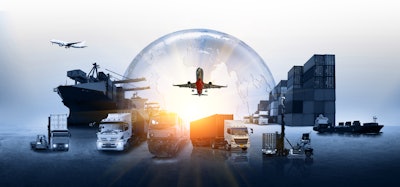
In our post-pandemic world, supply chain managers sometimes find themselves jumping from one fire to another, mitigating what feels like daily disruptions.
Their work is unquestionably valuable: Unforeseen supply chain disruptions can cost organizations 45% of an entire year’s profits over the course of a decade. Today, ongoing conflicts in the Red Sea have driven freight rates in the region from $1,200 to $4,500 per trip, even with a surplus of new vessels meant to alleviate pandemic-era disruptions.
Given the sprawling nature of the global supply chain, preventing every disruption is not realistic. But with proper planning, supply chain managers can mitigate the after-effects—and even limit the number of fires that must be put out.
Here’s how companies can use AI and other new tech along with an “anti-fragile” mindset to build a supply chain that can withstand unforeseen supply shocks.
Why Anti-fragile is the New Normal
Our increasingly data-driven and connected world has made supply chain simplicity all but extinct. Instead, efforts to maintain and optimize global operations are never-ending. As the tools evolve and uncover new business opportunities, businesses can better plan to take advantage of supply chain disruptions.
A 2023 Gartner survey of supply chain professionals found that just 9% of them expect to gain revenue from potential supply chain uncertainty—another 28% anticipated no gain or loss, while 63% expected a revenue loss. In an effort to be resilient and agile, weathering various levels of supply chain disruptions should be the bare minimum. Capitalizing on them and even gaining revenue is paramount to building a more resilient supply chain.
Anti-fragile supply chains are powered by technologies that allow companies to keep up with regular disruptions, reacting to production trends, changes in demand, and global events in real-time. While not every disruption can’t be planned for—low water levels in the Panama Canal slowing ship traffic for example—proactive planning allows organizations to navigate this new normal.
Over time, this transformation could lead to a completely new and autonomous supply chain experience as those equipped with new tech and tools will help reveal new business opportunities as well as improving lead times, offering more effective executive review cycles, and managing inventory levels quicker. Together, these improvements can ripple throughout the operations of the entire organization to optimize operations.
People and Probabilities: The Backbone of a Resilient Supply Chain
Companies often design operations to prioritize the customer experience, then work backwards to determine the proper structure. But the interconnectedness and frequency of disruption suggest that supply chains should perhaps be designed in reverse—emphasizing the team first.
Supply chain teams should be prepared to deal with this new normal but to do their jobs effectively they need the right tools and training. With team members working across multiple geographies and partnering with a variety of manufacturers, they need to be able to react in a cost-effective and sustainable way.
However, that’s not to say they’ll be truly “ready for everything,” either. The sheer number and range of disruptions today make it nearly impossible to create a truly standardized approach to supply chain planning—from geopolitical conflicts like those affecting the Red Sea to increasingly common environmental disasters like crop shortages and natural disasters.
Ultimately, anti-fragile supply chains rely on probability. You can’t predict exactly when and where the next hurricane will strike, but you can factor in historical data organizations to adapt if one does occur. The additional preparation and data requirements may drive initial investment, but the long-term business return should drive revenue thanks to the ability to recognize disruptions quickly and meet customers’ needs.
The clearest way to make this a reality: adopting new technology that can better understand risks in real-time.
How new tech can help remove risk and plan for disruptions
According to Deloitte’s 2023 Global Chief Procurement Officer Survey, just 2% of firms said that they had “high visibility” beyond tier one of their supplier networks. When you consider that most disruptions occur further down the supply chain, that is unacceptable for today’s businesses.
Tools like artificial intelligence and automation have made headlines as simple solutions to this issue. The faster that companies implement these technologies, the more they stand to benefit.
Predictive capabilities powered by AI are transformative for the logistics industry. They can help companies streamline supplier relationships, manage repairs on transportation fleets, forecast disruptions in real time and even speed up warehouse operations. However, Accenture’s 2024 supply chain report “Next Stop, Next Gen” found that just 9% of all companies use AI and generative AI widely across their supply chain.
The key moving forward is ensuring that AI is embedded across the entire supply chain strategy so that anyone in the organization can tap into its benefit. With improved data-driven intelligence and better contextualized business decisions through automation, companies can get closer to building not just an anti-fragile supply chain, but a self-healing, autonomous one.
For example, with in-depth and real-time information, AI can proactively recognize issues like crowded shipping routes or weather-related delays and suggest using another transportation method. Procurement teams can also see the cost or time implications that come with those suggestions as conditions evolve—predicting arrival times to help partners plan their inventories and keep costs down.
Not only can AI help source alternative suppliers in the event of a disruption, but it can also scrape key supplier information to help companies make more informed decisions from the beginning. This shift can ultimately transform businesses’ supply chains from digital, to adaptive and towards a truly autonomous experience. Whether they are in a digital transformation or already driving towards adaptability or taking first steps towards autonomous supply chain functions, ensuring that AI is built-in, relevant, and responsible will make it possible to deliver measurable business outcomes even when disruption feels like part of the daily routine.

















